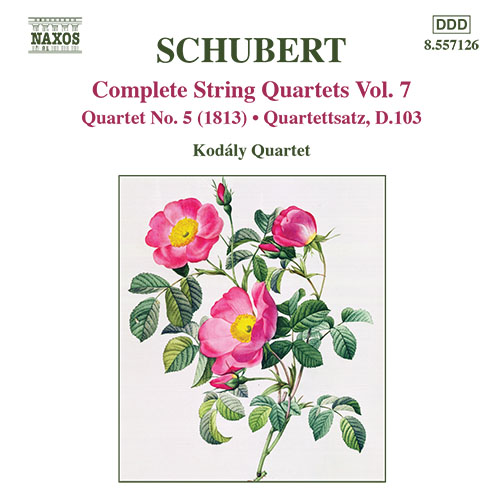SCHUBERT: String Quartets (Complete), Vol. 7
Writing for strings was as natural for Schubert as breathing. The Schubert family quartet consisted of his father and brothers, in which Franz played viola (and of course piano). Schubert's melodic gifts are among the most notable qualities of his enormous output. This volume contains a generous cross-section of lesser-known works for strings, along with the popular Quartettsatz and Five Minuets with String Trios.
Tracklist
Sakari, Petri (Conductor)
Sakari, Petri (Conductor)
Sakari, Petri (Conductor)
Sakari, Petri (Conductor)
Sakari, Petri (Conductor)
Sakari, Petri (Conductor)
Sakari, Petri (Conductor)
Sakari, Petri (Conductor)
Sakari, Petri (Conductor)

One of the foremost conductors of our time, Marin Alsop represents a powerful and inspiring voice. The 2023/24 season marks her fifth as chief conductor of the ORF Vienna RSO; her first as artistic director and chief conductor of the Polish National Radio Symphony; and her first as principal guest conductor of London’s Philharmonia Orchestra. She will begin a new position as principal guest conductor of The Philadelphia Orchestra in the 2024/25 season. She is also chief conductor of the Chicago Symphony Orchestra residency at the Ravinia Festival.
A full decade after becoming the first female conductor of the Last Night of the Proms, Alsop made history again in September 2023, as both the first woman and the first American to guest conduct three Last Nights.
In 2021, she assumed the title of music director laureate and OrchKids Founder of the Baltimore Symphony Orchestra after a 14-year tenure as music director, and in 2019, after seven years as music director, she became conductor of honour of Brazil’s São Paulo Symphony Orchestra (OSESP). Deeply committed to new music, she was music director of California’s Cabrillo Festival of Contemporary Music for 25 years.
Recognised with BBC Music Magazine “Album of the Year” and Emmy nominations in addition to GRAMMY, Classical BRIT and Gramophone awards, Alsop’s discography comprises more than 200 titles. The first and only conductor to receive a MacArthur Fellowship, she has also been honoured with the World Economic Forum’s Crystal Award, among many other awards and academic positions.
RELATED ARTICLES:
Entrevista com a maestrina Marin Alsop
Marin Alsop: La dama de la batuta
A Requiem in Reverse?: Marin Alsop talks to Jeremy Siepmann
Discovering Bartók: Marin Alsop talks to Jeremy Siepmann

Béla Bartók was one of the leading Hungarian and European composers of his time, proficient also as a pianist. He joined his friend Zoltán Kodály in the collection of folk music in Hungary and neighbouring regions, including, in his case, Anatolia. His work in this field deeply influenced his own style of composition, which is, however, very much more astringent in its apparent mathematical organisation than much of what Kodály wrote. He was out of sympathy with the government that replaced the immediate post-1918 republic in Hungary, where he was held in less official esteem than abroad, and moved in 1940 to the United States, dying there in relatively straitened circumstances in 1945.
Orchestral Music
Probably the best loved of Bartók’s orchestral compositions is the Concerto for Orchestra, commissioned by Koussevitzky for the Boston Symphony Orchestra. The two violin concertos are important additions to the solo violin repertoire, as is the Viola Concerto, now to be heard in two possible reconstructions. This last and the Third Piano Concerto were left in various stages of incompleteness when Bartók died. Both are moving works, while the earlier two piano concertos have much to offer. Other important orchestral works that form not infrequent parts of concert programmes are the Divertimento for Strings and the challenging Music for Strings, Percussion and Celesta. The energetic Romanian Dances appear in various versions, including one for solo violin and string orchestra, arranged from an original piano composition.
Stage Music
Bartók wrote relatively little for the theatre. His opera Duke Bluebeard’s Castle was first staged in Budapest in 1918, a year after the première of the ballet The Wooden Prince. The pantomime The Miraculous Mandarin enjoyed a succès de scandale in Cologne, where it was first staged in 1926.
Chamber Music
Bartók’s six string quartets are a significant and important part of repertoire, extending the musical and technical range of the form. The 44 Duos for two violins are primarily educational compositions, but make attractive concert pieces in various groupings suggested by the composer, while the Sonata for Solo Violin follows, in a modern idiom, the example of J.S. Bach. Bartók’s two violin sonatas date from the early 1920s, while Contrasts, for violin, clarinet and piano, was written in America for Szigeti, Benny Goodman and the composer.
A work of some importance is the spectacular Sonata for Two Pianos and Percussion, later rescored by the composer for two pianos and orchestra. The original version makes use of three kettledrums, a xylophone, two side drums, cymbals, suspended cymbal, bass drum, triangle and tam-tam, with the two pianos. It has an extended first movement, a night-music second and a tautly rhythmic third. Written in 1937, the sonata experiments fruitfully with the varied percussive sonorities of pianos and percussion instruments.
Piano Music
Mikrokosmos consists of six books of pieces of progressive difficulty, intended to be used for teaching, with the last two volumes including more demanding pieces possible for concert use. Folk melodies form the basis of 85 Pieces for Children, while Allegro barbaro shows the composer in a more aggressive mood.































